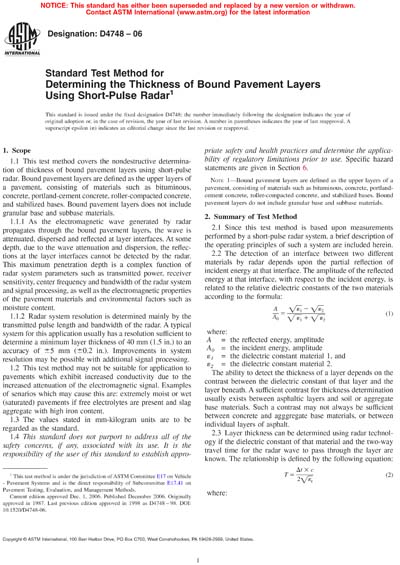Historical
ASTM D4748-06
Standard Test Method for Determining the Thickness of Bound Pavement Layers Using Short-Pulse Radar
1.1 This test method covers the nondestructive determination of thickness of bound pavement layers using short-pulse radar. Bound pavement layers are defined as the upper layers of a pavement, consisting of materials such as bituminous, concrete, portland-cement concrete, roller-compacted concrete, and stabilized bases. Bound pavement layers does not include granular base and subbase materials.
1.1.1 As the electromagnetic wave generated by radar propagates through the bound pavement layers, the wave is attenuated, dispersed and reflected at layer interfaces. At some depth, due to the wave attenuation and dispersion, the reflections at the layer interfaces cannot be detected by the radar. This maximum penetration depth is a complex function of radar system parameters such as transmitted power, receiver sensitivity, center frequency and bandwidth of the radar system and signal processing, as well as the electromagnetic properties of the pavement materials and environmental factors such as moisture content.
1.1.2 Radar system resolution is determined mainly by the transmitted pulse length and bandwidth of the radar. A typical system for this application usually has a resolution sufficient to determine a minimum layer thickness of 40 mm (1.5 in.) to an accuracy of 5 mm (0.2 in.). Improvements in system resolution may be possible with additional signal processing.
1.2 This test method may not be suitable for application to pavements which exhibit increased conductivity due to the increased attenuation of the electromagnetic signal. Examples of senarios which may cause this are: extremely moist or wet (saturated) pavements if free electrolytes are present and slag aggregate with high iron content.
1.3 The values stated in mm-kilogram units are to be regarded as the standard.
This standard does not purport to address all of the safety concerns, if any, associated with its use. It is the responsibility of the user of this standard to establish appropriate safety and health practices and determine the applicability of regulatory limitations prior to use.
Bound pavement layers are defined as the upper layers of a pavement, consisting of materials such as bituminous, concrete, portland-cement concrete, roller-compacted concrete, and stabilized bases. Bound pavement layers do not include granular base and subbase materials.
ASTM International [astm]

